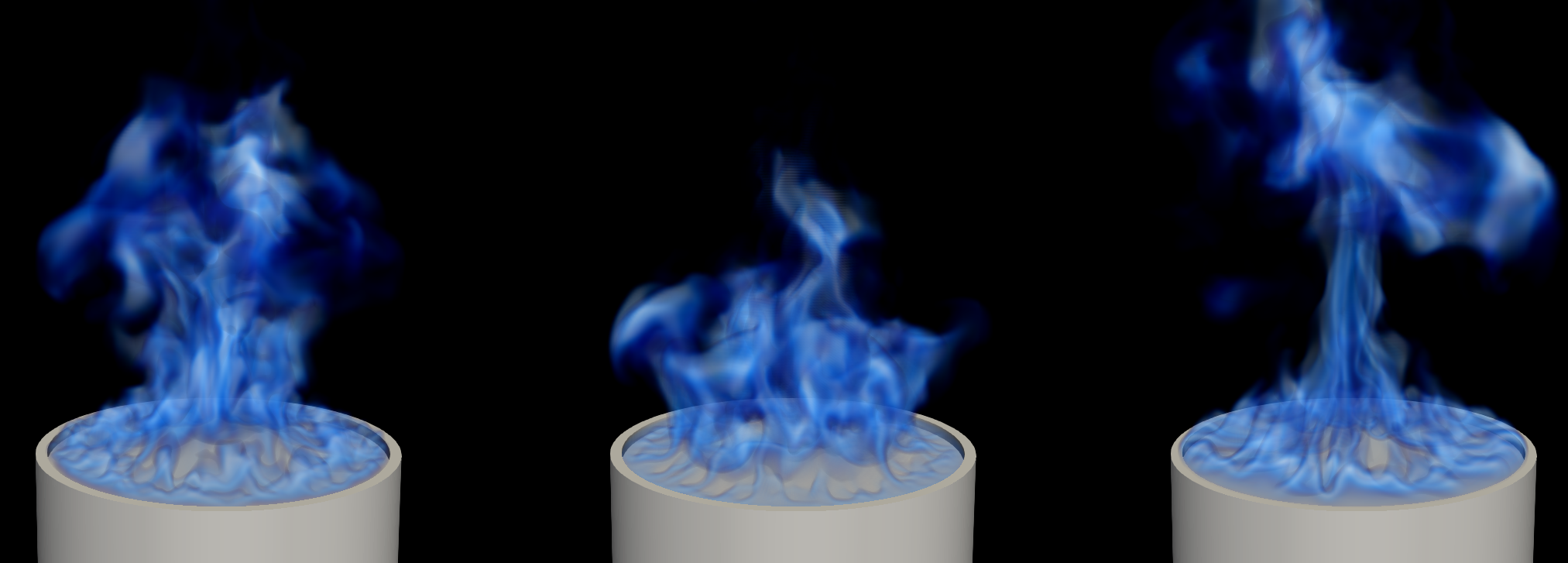News Story
UMD Research Team Uses Massive Computer Power to Perform High Resolution Simulations of Turbulent Pool Fires

A sample of instantaneous snapshots of the simulated methanol pool flame. The flame is visualized using volume rendering of the high temperature region (defined as the region where temperatures are larger than 800 K).
A University of Maryland (UMD) research team focused on the computational study of a methanol-fueled turbulent pool flame provides new insight into the unstable structure of the flame, and into the convective and radiative heat transfer processes that determine the intensity of the gas-to-liquid thermal feedback, which controls the overall flame size. The study uses FireFOAM – a fire model based on Computational Fluid Dynamics and developed by FM Global – and is funded by FM Global and by the National Science Foundation (NSF). High spatial resolution (millimeter-scale) was utilized in order to capture the thin boundary layer flames that repeatedly form at the burner rim above the liquid pool surface and the small plume-like structures – called 'thermals' – that grow along the flame surface as a result of buoyancy-driven Rayleigh-Taylor instabilities.
The study – led by Fire Protection Engineering (FPE) Professor Arnaud Trouvé – entitled, "Large Eddy Simulation of the Unstable Flame Structure and Gas-to-Liquid Thermal Feedback in a Medium-Scale Methanol Pool Fire," was published November 12 in Combustion and Flame (https://doi.org/10.1016/j.combustflame.2020.10.055). Mohamed Ahmed, a Mechanical Engineering PhD student advised by Trouvé, served as first author on the study.
"The high resolution provided in these simulations reveals the dynamical details found in these pool flames," said Trouvé. "We refer to them as numerical experiments. The comparisons between experimental data and numerical results ranged from good to excellent."
Indeed, the heat fluxes at the methanol pool surface were predicted with an accuracy of 25%. The computational cost of the simulation performed with the finest resolution is 280,000 CPU hours.
"This simulation would take 32 years on a single-processor computer," Trouvé said. "Instead, we used 288 processors over a 6-week duration on a large parallel machine made available by NSF (https://www.xsede.org)."
These high-resolution simulations can be used as reference solutions in studies that use a coarser resolution, as would be the case in fire safety engineering projects. Moreover, the ability to simulate the thermal feedback in liquid fuel pool fires is viewed as an intermediate, but essential step on the route to simulate more complex fire configurations that feature solid fuel sources and flame spread.
The study considers a 30-cm-diameter methanol pool fire previously studied experimentally at the University of Waterloo in Canada and at the National Institute of Standards and Technology (NIST). This fire configuration has also been recently adopted by the "IAFSS Working Group on Measurement and Computation of Fire Phenomena" as one of several target experiments recommended for validation of fire models based on Computational Fluid Dynamics (see https://iafss.org/macfp/).
Published November 30, 2020









